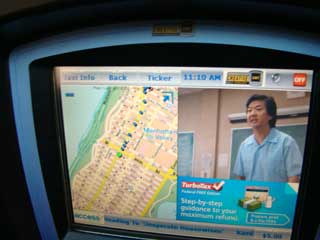Digital taxi
Old taxi cabs gradually disappear from city streets giving way to new and modern models. Try to find in Germany a cab that's not a flashy Mercedes! Naturally, this upgrade usually includes numerous technical gadgets that are added to the taxi. At present two major trends can be easily seen: installing GPS-systems, video cameras and recorders (traffic safety features) and installing video screens and digital monitors in taxi headrests and other places.
Most common are 7” or 9” screens of 16:9 format, though variations are not uncommon. As a rule, the matrix resolution is sufficient to display video and separating the screen into sectors that are filled with diverse information. The options may include hidden speakers, motion sensors, a lock that protects memory cards etc.
The cab with touchpad advertizing screen turns into a mobile media complex where passengers may look through offered advertising clips and informational resources, especially while waiting in insufferable traffic jams. There is a saying that “a good story cuts the long trip by half” or something to that effect. This is definitely true when referred to a “digital taxi”.
 |
 |
| Touchpad advertizing screens in a New York taxi cab | |
Such digital advertising allows covering a wide audience of consumers with high income. Sitting in a taxi we do not consider advertising as intrusive. Rather an inventive way to pass the time in transit. We can identify several approaches to offering digital advertising to taxi passengers. Simplified solutions allow passengers to watch with no opportunity to interfere in the operation of the device. The LCD screen in-built into the headrest or back of the front seat displays clips from flash-card in a loop. The motion sensor switches off the screen in case there are no passengers in a cab.
However more sophisticated solutions were quick to appear. With the touch screen technology getting cheaper by the minute, more and more taxis are now equipped with these advanced screens. The passenger may choose what to read and watch: entertainment information, weather forecast, information about the city and its sights or about fashionable restaurants. He may initialize the GPS-map to watch how the taxi moves towards the destination or watch advertising commercials. However, part of the screen is always dedicated to digital advertising: for example, in the form of brand names or logos. Thus, the passenger will always be exposed to some degree of advertising during the trip.
 |
 |
| Touchpad advertizing screens in taxi cab | |
A Shanghai-based company TouchMedia is worth mentioning here, too. Established in 2007, it quickly expanded to 12 major cities, including Beijing and Guangzhou. By October 2010, the company installed small advertizing touch-screens (316x179 mm) in 22 thousand taxis: 10 thousand in Shanghai, 6 thousand in Beijing, 4 thousand in Guangzhou, and 2 thousand in Shenzhen (with the plan to add another 10 thousand cars shortly).
What makes this company stand out among others is its approach to data transfer: each taxi advertizing screen has a unique IP-address and telephone card with mobile Internet. The cars are equipped with GPS transmitters, and the company can update advertising and informational data at regular intervals. Also, Touch Media can find out what advertising logos were in fact activated and how many times (the log-file for each monitor may be given to a client). The number of contacts is calculated using the following formula: 1 taxi carries approximately 40 groups of passengers (each group consisting of 1.3 people on the average). Thus, when buying advertising time on 1000 taxis a client will have a proof of 1.5 million people per month (200 thousand of which are using the sensor monitors actively during the trip).
It is interesting to note that some companies conduct taxi upgrades in a systematic manner by building informational and advertising networks. There already exist networks where the data is transferred via changing flash-cards (outdated and time consuming process), or though Wi-Fi or even via the dedicated TV channel. For example, Clear Channel Taxi Media created a digital NY10 network for New York taxis.
The NY10 network airs NBC news and entertainment content and advertising on taxi screens developed by Creative Mobile Technologies’ FREEdom Solution. The advertizing taxi screens also provide passengers with live digital maps and the ability to pay cab fare by debit or credit card. The in-built loudspeakers always enhance the effect of a video clip. Thus, advertisers receive a new and novel platform to reach elite audience and engage both eyes and ears of bored taxi passengers.
Some Chinese companies, for example, Guangzhou Pearl River City TV with 11 thousand taxi cabs approach the task on a grand scale: the company registered a TV channel that provides coverage within city limits and immediate transfer of data to all cars in the city. With the increase in the number of the digital taxis the expenses of the company do not grow while profits skyrocket.
So far this technology is still being tested. But a day when all taxis, busses and metro cars will be linked in unified informational networks is soon to come. Millions of passengers will be exposed to information and advertising while out-of-home. The audience of taxi cabs is guaranteed to be high income and thus is the most attractive to advertisers. No surprise that it is this area that is developing faster than others.





